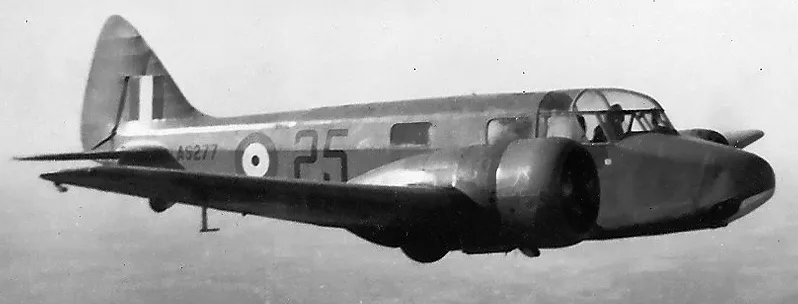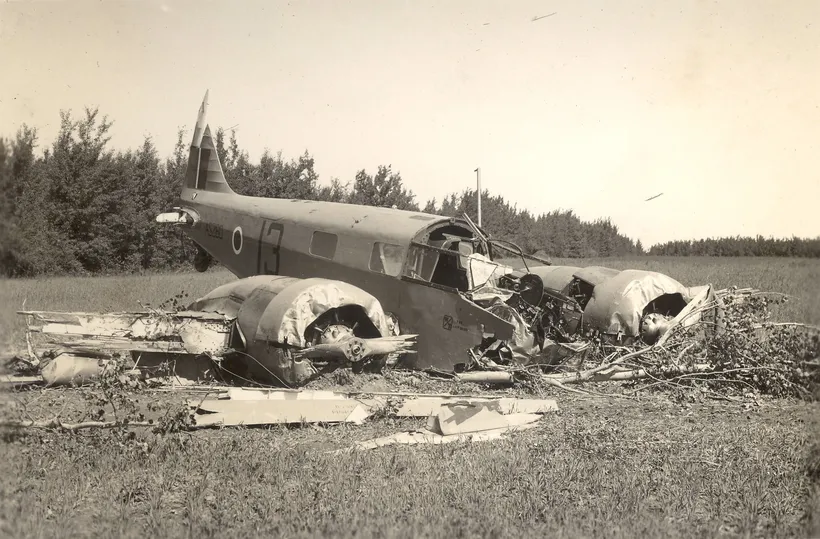Delamere, Eric Robert (Leading Aircraftman)
Killed in Flying Accident 1942-July-27


Birth Date: 1921
Born:
Parents:
Spouse:
Home:
Enlistment:
Enlistment Date: unkown date
Service
RAFVR
Unit
36 SFTS- Service Flying Training School (RAF)
Base
RCAF Stn. Penhold, Alberta
Rank
Leading Aircraftman
Position
Service Numbers
1233726
This incident involved multiple aircraft:
- Oxford Mk. II Serial: AS924
- Oxford Mk. II Serial: BG304
All the above aircraft in the above list are referenced in this report.
Accident Card - Airspeed Oxford Mk. II serial:BG304
This accident involved 2 aircraft on 1942-July-27. They are: Oxford s/n AS924, Oxford s/n BG304.
This accident involved 2 people. Delamere ER, Forrest JWS
This accident had 1 fatality. Leading Aircraftman Eric Robert Delamere RAFVR Killed in Flying Accident service no:1233726 Oxford BG304
Oxford serial: BG304

Airspeed A.S. 10 Oxford Mk. II, RCAF (Serial No. AS277), 25, in flight over Saskatchewan, 1942.
The Airspeed AS.10 Oxford was a twin-engine monoplane aircraft developed and manufactured by Airspeed. It saw widespread use for training British Commonwealth aircrews in navigation, radio-operating, bombing and gunnery roles throughout the Second World War.
The Oxford was developed by Airspeed during the 1930s in response to a requirement for a capable trainer aircraft that conformed with Specification T.23/36, which had been issued by the British Air Ministry. Its basic design is derived from the company's earlier AS.6 Envoy, a commercial passenger aircraft. Performing its maiden flight on 19 June 1937, it was quickly put into production as part of a rapid expansion of the Royal Air Force (RAF) in anticipation of a large-scale conflict.
As a consequence of the outbreak of war, many thousands of Oxfords were ordered by Britain and its allies, including Australia, Canada, France, New Zealand, Poland, and the United States. Following the end of the conflict, the Oxford continued to achieve export sales for some time, equipping the newly formed air forces of Egypt, India, Israel, and Yugoslavia. It was considered to be a capable trainer aircraft throughout the conflict, as well as being used a general-purpose type. A large number of Oxfords have been preserved on static display. Wikipedia
Aircraft Images
Oxford AS924
Oxford Mk. II AS924
Winter conversion set installed during erection by No. 4 Repair Depot at Scoudouc, NB. To No. 4 Training Command on 12 March 1942, for use by No. 36 Service Flying Training School at Penhold, Alberta. Collided with Oxford X6882 at Medicine Hat at 23:16 on 22 April 1942, when it attempted to take off from taxi strip. To Aircraft Repair, 31 July to 11 November 1942. To storage with No. 4 Training Command when completed. Issued from storage on 13 August 1943 (or 1942?), for use by No. 35 Service Flying Training School at North Battleford, Saskatchewan. With No. 34 Service Flying Training School at Medicine Hat when it was struck on the ground with Oxford AT456 on 23 August 1943, at Medicine Hat. Application to write off dated 27 January 1944. To Aircraft Repair for scrapping on 29 January 1944. Serviceable and repairable components shipped to No. 10 Repair Depot.1942-02-02 Taken on Strength Eastern Air Command at No. 1 Port Detachment 2019-08-20
1942-April-22 Accident: 34 Service Flying Training School Loc: Aerodrome Names: Fielder | Oliver | Pippard
1942-July-27 Accident: 36 Service Flying Training School Loc: Aerodrome Names: Delamere | Forrest
1943-August-23 Accident: 32 Service Flying Training School Loc: Aerodrome Names: Buytendyk
1944-04-11 Struck off Strength Struck off, reduced to components 2019-08-20
Oxford BG304
Oxford Mk. II BG304
1942-03-12 Taken on Strength 2022-02-07
1942-July-27 Accident: 36 Service Flying Training School Loc: Aerodrome Names: Delamere | Forrest
1943-02-22 Struck off Strength 2022-02-07
Unit Desciption
36 SFTS (36 Service Flying Training School)
Graduates of the EFTS "learn-to-fly" program went on a Service Flying Training School (SFTS) for 16 weeks. For the first 8 weeks the trainee was part of an intermediate training squadron; for the next 6 weeks an advanced training squadron and for the final 2 weeks training was conducted at a Bombing & Gunnery School. The Service schools were military establishments run by the RCAF or the RAF.
There were two different types of Service Flying Training Schools. Trainees in the fighter pilot stream went to an SFTS like No. 14 Aylmer, where they trained in the North American Harvard or North American Yale. Trainees in the bomber, coastal or transport pilot stream went to an SFTS like No. 5 Brantford where they learned multi-engine technique in an Airspeed Oxford, Avro Anson or Cessna Crane.

For Information on RCAF Station Penhold see here
RCAF.Info - RCAF Station Penhold AB
RCAF.Info - Relief Landing Field Innisfail AB
RCAF.Info - Relief Landing Field Blackfalds AB
![]() Harvard Historical Aviation Society
Harvard Historical Aviation Society
![]() Midland Aircraft Recovery Group - Men Of 36 SFTS
Midland Aircraft Recovery Group - Men Of 36 SFTS
![]() Bomber Command Museum Of Canada - 36 SFTS
Bomber Command Museum Of Canada - 36 SFTS